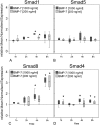An investigation of BMP-7 mediated alterations to BMP signalling components in human tenocyte-like cells
- PMID: 27406972
- PMCID: PMC4942578
- DOI: 10.1038/srep29703
An investigation of BMP-7 mediated alterations to BMP signalling components in human tenocyte-like cells
Abstract
The incidence of tendon re-tears post-surgery is an ever present complication. It is suggested that the application of biological factors, such as bone morphogenetic protein 7 (BMP-7), can reduce complication rates by promoting tenogenic characteristics in in vitro studies. However, there remains a dearth of information in regards to the mechanisms of BMP-7 signalling in tenocytes. Using primary human tenocyte-like cells (hTLCs) from the supraspinatus tendon the BMP-7 signalling pathway was investigated: induction of the BMP associated Smad pathway and non-Smad pathways (AKT, p38, ERK1/2 and JNK); alterations in gene expression of BMP-7 associated receptors, Smad pathway components, Smad target gene (ID1) and tenogenic marker scleraxis. BMP-7 increases the expression of specific BMP associated receptors, BMPR-Ib and BMPR-II, and Smad8. Additionally, BMP-7 activates significantly Smad1/5/8 and slightly p38 pathways as indicated by an increase in phosphorylation and proven by inhibition experiments, where p-ERK1/2 and p-JNK pathways remain mainly unresponsive. Furthermore, BMP-7 increases the expression of the Smad target gene ID1, and the tendon specific transcription factor scleraxis. The study shows that tenocyte-like cells undergo primarily Smad8 and p38 signalling after BMP-7 stimulation. The up-regulation of tendon related marker genes and matrix proteins such as Smad8/9, scleraxis and collagen I might lead to positive effects of BMP-7 treatment for rotator cuff repair, without significant induction of osteogenic and chondrogenic markers.
Figures








Similar articles
-
Bone morphogenetic proteins.Growth Factors. 2004 Dec;22(4):233-41. doi: 10.1080/08977190412331279890. Growth Factors. 2004. PMID: 15621726 Review.
-
BMP-2 and BMP-7 affect human rotator cuff tendon cells in vitro.J Shoulder Elbow Surg. 2012 Apr;21(4):464-73. doi: 10.1016/j.jse.2011.01.015. Epub 2011 Mar 30. J Shoulder Elbow Surg. 2012. PMID: 21454098
-
Influence of age on the cell biological characteristics and the stimulation potential of male human tenocyte-like cells.Eur Cell Mater. 2012 Jul 12;24:74-89. doi: 10.22203/ecm.v024a06. Eur Cell Mater. 2012. PMID: 22791374
-
The Role of Scleraxis in Fate Determination of Mesenchymal Stem Cells for Tenocyte Differentiation.Sci Rep. 2015 Aug 20;5:13149. doi: 10.1038/srep13149. Sci Rep. 2015. Retraction in: Sci Rep. 2018 Nov 06;8(1):16377. doi: 10.1038/s41598-018-34658-3. PMID: 26289033 Free PMC article. Retracted.
-
BMP-Smad 1/5/8 signalling in the development of the nervous system.Prog Neurobiol. 2013 Oct;109:28-41. doi: 10.1016/j.pneurobio.2013.07.002. Epub 2013 Jul 24. Prog Neurobiol. 2013. PMID: 23891815 Review.
Cited by
-
Bone morphogenetic protein 7 promotes resistance to immunotherapy.Nat Commun. 2020 Sep 24;11(1):4840. doi: 10.1038/s41467-020-18617-z. Nat Commun. 2020. PMID: 32973129 Free PMC article.
-
Genetic predisposition of BMP7 polymorphisms to lumbar disk herniation in the Chinese Han population.Cell Cycle. 2024 Feb;23(4):466-477. doi: 10.1080/15384101.2024.2342703. Epub 2024 Apr 23. Cell Cycle. 2024. PMID: 38651735 Free PMC article.
-
Differential bioactivity of four BMP-family members as function of biomaterial stiffness.Biomaterials. 2022 Feb;281:121363. doi: 10.1016/j.biomaterials.2022.121363. Epub 2022 Jan 4. Biomaterials. 2022. PMID: 35063741 Free PMC article.
-
Is NO the Answer? The Nitric Oxide Pathway Can Support Bone Morphogenetic Protein 2 Mediated Signaling.Cells. 2019 Oct 18;8(10):1273. doi: 10.3390/cells8101273. Cells. 2019. PMID: 31635347 Free PMC article.
-
The roles of inflammatory mediators and immunocytes in tendinopathy.J Orthop Translat. 2018 Apr 14;14:23-33. doi: 10.1016/j.jot.2018.03.003. eCollection 2018 Jul. J Orthop Translat. 2018. PMID: 30035030 Free PMC article. Review.
References
-
- Aydin N., Kocaoglu B. & Guven O. “Single-row versus double-row arthroscopic rotator cuff repair in small- to medium-sized tears”, J. Shoulder. Elbow. Surg. 19(5), 722–725 (2010). - PubMed
-
- Gerhardt C. et al. “Arthroscopic single-row modified mason-allen repair versus double-row suture bridge reconstruction for supraspinatus tendon tears: a matched-pair analysis”, Am. J. Sports Med. 40(12), 2777–2785 (2012). - PubMed
-
- Klatte-Schulz F. et al. “Relationship between muscle fatty infiltration and the biological characteristics and stimulation potential of tenocytes from rotator cuff tears”, J. Orthop. Res. 32(1), 129–137 (2014). - PubMed
-
- Klatte-Schulz F. et al. “Influence of age on the cell biological characteristics and the stimulation potential of male human tenocyte-like cells”, Eur. Cell Mater. 24, 74–89 (2012). - PubMed
Publication types
MeSH terms
Substances
LinkOut - more resources
Full Text Sources
Other Literature Sources
Research Materials
Miscellaneous

